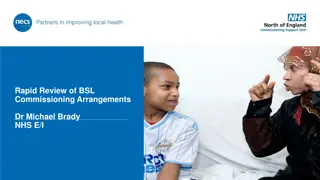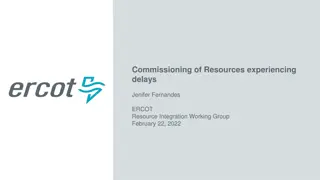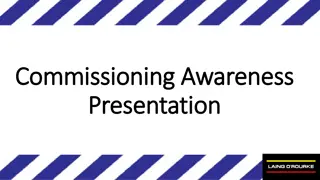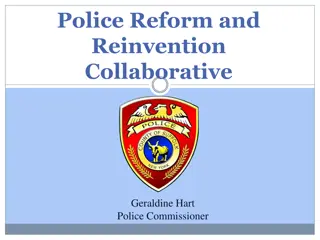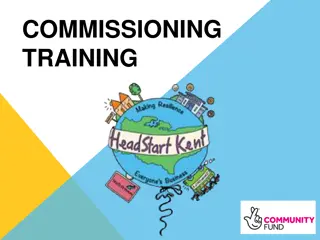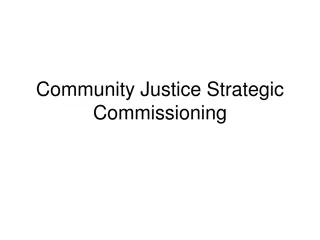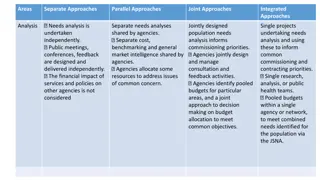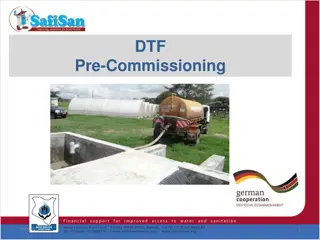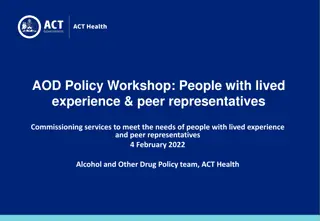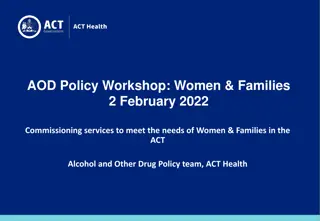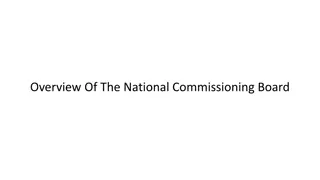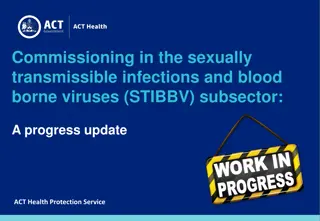Community Commissioning Collaborative Design Workshop - August 9th
The Community Commissioning Collaborative Design Workshop on August 9th focuses on sexually transmissible infections and blood-borne viruses public health regulation. The workshop includes sessions on health services commissioning, viral hepatitis, and HIV, aiming to address emerging needs and priorities in the sector.
Download Presentation

Please find below an Image/Link to download the presentation.
The content on the website is provided AS IS for your information and personal use only. It may not be sold, licensed, or shared on other websites without obtaining consent from the author. Download presentation by click this link. If you encounter any issues during the download, it is possible that the publisher has removed the file from their server.
E N D
Presentation Transcript
Community Commissioning Collaborative Design Workshop #2 9 August 9:30am 12:30pm Venue: Zoom Sexually Transmissible Infections and Blood Borne Viruses Public Health Regulation and Projects Health Protection Service ACT Health Directorate
Agenda Tuesday, 9th August 2022 Time: 9:30am 12:30pm Venue: Zoom Workshop 2 - Viral Hepatitis / HIV Presenter/ No Agenda Item Content Time Facilitator Tea/Coffee available 900 Welcome and Introduction 1 Introductions, Objectives and Overview - Outlining the process for the discussion & the expected outputs Sean Lowry 930 Guiding Principles for Commissioning Health Services in the ACT 2 Context and Aims Fellon Gaida 945 Outcomes which we are trying to achieve through commissioning - the process and our progress thus far Questions, queries and comments on the commissioning framework and process thus far. Openly address and discuss any risks, issues, concerns and challenges. 3 Facilitated Discussion Sean Lowry 1000 Snapshot Health Needs Assessment 4 Assess current and future needs of clients, communities and the human services system Fellon Gaida 1015 Discussion on local models of care and emerging priorities Where can we improve in providing services? What are the emerging needs and priorities of the sector ? What inputs or enablers are required to support us to meet the needs of our sector? How will we know if we are making an impact and making a difference ? 6 All 1100 8 Closing Comments Bringing it all together Summary and Clarification Sean Lowry 1215
Facilitated Discussion Questions, queries and comments on the commissioning framework and process thus far. Openly address and discuss any risks, issues, concerns and challenges. Good engagement with the sector to date Conversations have focussed on the model of care which is productive Appears to be better connection with the data and as a result greater understanding of the nuance of the sector Strengths based conversations are taking place Important that we leverage from our successes ( for example gains made over the decades in the HIV sector) Need to respond to and overtly address the realities of decommissioning some services including impact on clients and community, service providers and employees, and target group perceptions.
1. Where can we improve in providing services to meet our sectors needs? Where are we seeing emerging demand in new or existing services or similarly where are there gaps in the provision of services or the engagement of target groups (volume, access, geographic, demographic and cultural reach) Consider inclusion of transmen, chemsex, non-binary and bisexual groups in the health needs assessment Subsets of CALD population need to be specified not merely all under the CALD banner and not only by VISA status Health promotion and education is a major enabler and equates to lower notifications The NEP is a success story in Australia consider how we leverage this level of engagement to other challenges Consider expanding S100 access to Sex Workers, DV and homeless demographies Continue to utilise and train pharmacy and aged care workforce Focus on additional psycho-social support for (Hep B an Hep C) Case Management support is often provided in many cases to clients in order to focus on their most important issues The Clinic Van has capacity to grow the breadth of services available through this outreach model good engagement with likely target groups Nurse Practitioner models for MHAODS and HepB/C seem to be working in Victoria recognising they are difficult to recruit to Significant gaps in Heb B testing and notification. Unsure of a peer led approach to Hep B perhaps CALD directed and supported by a Nurse Practitioner including the option for a partnership with the liver clinic. Clinical outreach models will require additional support for the clinician ( clinical governance, mentoring, career pathways and progression)
2. What inputs or enablers are required to improve? Identify new and critical service inputs to be considered through future procurement to meet this growing demand, plug this service gap or coverage, engage this particular target group or culture. This could include new partnerships, better data sharing or a different approach. The evolution of service delivery organisations from grass roots to now becoming more professional organisations where often the client/consumer becomes the workforce. Fragmentation of agency funding into Heb B, C and HIV is challenging for many service providers. Flexible contracts which allow the service provider to determine the best means of supporting and reaching their target groups is key Flexibility in reporting is required rather than completing cells in a standardised excel. Co-design of reporting templates would be helpful Jointly developing and defining short, medium and long term impacts and outcomes would help the sector with reporting and delivery focus
3. How will we know when we have made an improvement and a positive impact? What measures or indicators will tell us we are meeting our communities needs? Tracking client engagement scores with a particular service could be a good impact measure. Not all interventions, screenings or treatments occur in the first interaction. Trust must be built between the service and individual. Identify stages and phases of engagement with clients. Reach /teach / treat example. Build long-term pipeline of engagement

 undefined
undefined








